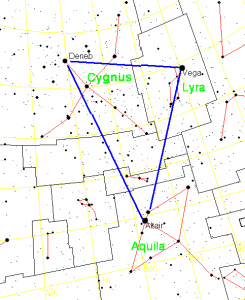Stargazing in July has its own challenges: the evenings are light, the thunders are frequent, the crawling and flying bugs are active. But warm Summer nights make up for all these inconveniences – if you’ve even been stargazing when the thermometer dipped to negative digits, you sure would agree with us.
So…what are you waiting for? Let’s go stargazing! It might be a quick trip to a local park, a walk up a nearby hill or – best of all – a journey to a designated Dark Skies area. Bring a picnic blanket or a garden recliner, a sleeping bag if the night is chilly, give your eyes time to adjust and enjoy the celestial show! To avoid disappointment, check the weather forecast and astronomical forecast (we like Clear Outside) before setting off.
Here is what’s up in the sky in July 2021!
July 2021 planets
Four out of five naked eye planets – Venus, Mars, Jupiter and Saturn – will be visible in July 2021.
Venus and Mars are best viewed in the evening: while Venus will continue to shine brightly all month long, Mars will gradually fade away as the month progresses.
The two planets will ‘meet’ in the sky in the morning hours of July 13th. Depending on your location you might be able to see Mars and Venus close by (or in conjunction, as astronomers call it) in the evening of either on July 12th or 13th. The planets might appear as one shiny star in the sky and you might need binoculars to see them as two separate objects.
Jupiter and Saturn will be up in the July 2021 skies all night long. You can find the two gas giants once it gets dark, or spot them before the Sun rises – it’s up to you!
By the way, July 5th would be a special day for our very own planet too! On that day the Earth will reach aphelion, that is the farthest from the Sun point in its orbit. (And yet it is Summer time here in the Northern Hemisphere! How weird is that?)
July Moon
The bright Moon makes for a perfect naked-eye-stargazing target. But to see the whole new world up there, have a look at the Moon through a telescope or binoculars. No need to buy any optics – chances are your local astronomical society holds stargazing sessions not far from where you live (see the list of Astronomy clubs and societies in the UK).
Here is the lunar phases calendar for July 2021
01 July 🌗 Last Quarter Moon
10 July 🌑 New Moon
17 July 🌓 First Quarter Moon
24 July 🌕 Full Moon ‘Buck’ Moon
The July 2021 Full Moon will coincide with the 52nd anniversary of the Apollo 11 landing! What a night to observe the Moon and to think about lunar exploration!
31 July 🌗 Last Quarter Moon
July meteor showers
Meteors from two different meteor shower families will graze the skies in July 2021.
✨ The Perseid meteor shower, one of the highlights of the Summer in the Northern Hemisphere, will begin on 17 July. The shower will peak on August 12-13, therefore to see the Perseids at their best you might want to wait until mid-August.
✨ Another shower, Southern Delta Aquariids, will be active from mid-July to mid-August and reach its maximum on July 28-29. While the Southern Hemisphere observers will get the best view, here ‘on the other side of the World’ we will see some Southern Delta Aquariid meteors too. For best chances, observe from a dark location before dawn.
Did you know that astronomers are still not sure what the parent body of Delta Aquariids is? Find out more in our blog post July Delta Aquariids and their peculiar origin!
July constellations

Credit: Tomruen at en.wikipedia, Public domain, via Wikimedia Commons
The constellations to look out for in July 2021 are Draco, Hercules, Corona Borealis, Serpens and Ophiuchus.
Another popular star pattern you can easily find in the eastern evening sky this month is the Summer Triangle. This is an asterism (i.e. a recognizable pattern), not a constellation, made of 3 stars from 3 different constellations: Deneb (in Cygnus), Vega (in Lyra) and Altair (in Aquila).
Vega, the brightest of the three, marks the top of the triangle. Altair, the second brightest, marks the lower right vertex, while Deneb, the dimmest star in the Triangle, the lower left vertex.
If you observe the Summer Triangle from a dark location, you might be able to see a faint glowing band that runs along the line that joins Deneb and Altair. That’s our own Milky Way Galaxy!
Happy July 2021 stargazing!
Would you like to hear more stargazing tips and Astronomy news? Do you want to to find out about our upcoming public events? Follow WonderDome Portable Planetarium on Twitter and Facebook or go to our web site wonderdome.co.uk!


